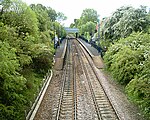St John and St Mary Magdalene Church, Goldthorpe
20th-century Church of England church buildingsAnglo-Catholic church buildings in South YorkshireAnglo-Catholic churches in England receiving AEOBuildings and structures in the Metropolitan Borough of BarnsleyChurch of England church buildings in South Yorkshire ... and 2 more
Churches completed in 1916Grade II listed churches in South Yorkshire

St John the Evangelist and St Mary Magdalene Church is a parish church in the Church of England Diocese of Sheffield in Goldthorpe, near Barnsley, South Yorkshire, England.
Excerpt from the Wikipedia article St John and St Mary Magdalene Church, Goldthorpe (License: CC BY-SA 3.0, Authors, Images).St John and St Mary Magdalene Church, Goldthorpe
Lockwood Road,
Geographical coordinates (GPS) Address External links Nearby Places Show on map
Geographical coordinates (GPS)
| Latitude | Longitude |
|---|---|
| N 53.5356 ° | E -1.30192 ° |
Address
St John Evangelist & St Mary Magdelene
Lockwood Road
S63 9JZ
England, United Kingdom
Open on Google Maps







